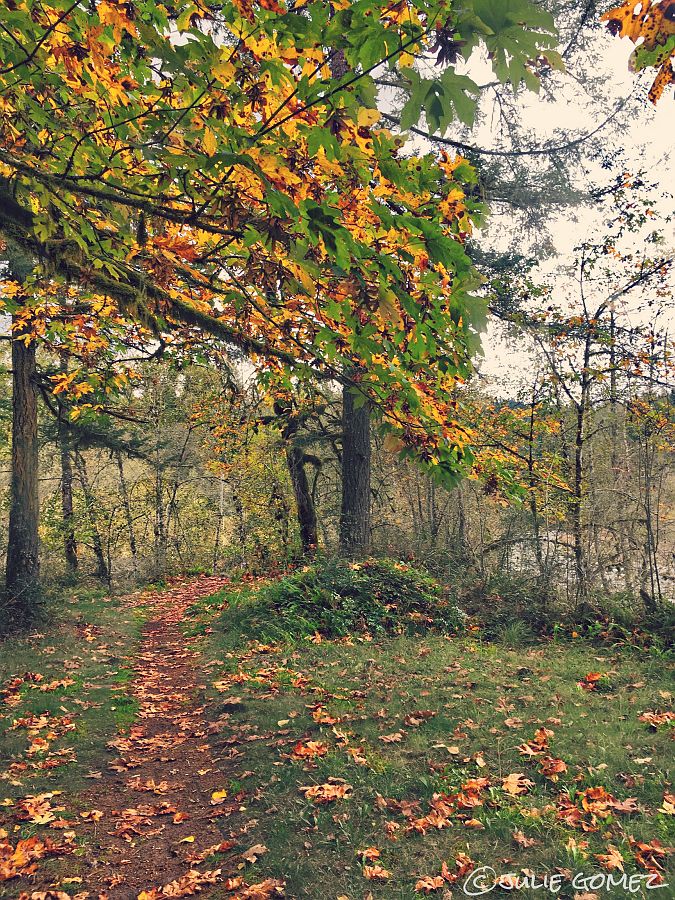
Time is like a river you cannot touch the water twice, because the flow that has passed will never pass again. Enjoy every moment of life. —Author Unknown
_____
One of my favorite places to visit, especially in autumn, is Dodge Park in the Sandy River Canyon; a rural park with old-growth forest in which some of the trees and groves (having escaped the logging era) are more than 500 years old. This is a park where deer and black bear roam, and where salmon and steelhead return to spawn. For more than 100 years, people have visited this site. The park is named for Frank Dodge, a photographer, and the second superintendent of the Portland Water Bureau who recorded river levels between 1897 to 1914. The park covers fourteen forest acres along the Sandy River, and confluence of Bull Run River (named for the free-range cattle that once roamed here) and is a source of Portland’s drinking water.
I have known this place all my life. And like so many before me, I can recall plenty of family picnics here. I now share this same love of place with my husband—although there is usually more fishing than picnicking involved, and that’s ok too. For almost twenty years, we’ve made it a tradition to visit Dodge Park in autumn—a very peaceful time of year with few visitors. On this day, a few anglers fished the Sandy, although the Chinook had yet to arrive this far upriver.




We visited our favorite spot among old-growth Douglas-firs, maples, and cottonwoods, and where Bull Run River meets the Sandy. Upstream, along Bull Run River, a fish weir was being put together to record the salmon that would soon return to their birthplace. The weather was mild with scattered clouds and sun breaks with occasional sprinkles of rain. Cottonwood leaves spiced the air with their intoxicating, sweet fragrance. Along the riverbanks, clusters of snowberries hung on skinny twigs that looked too frail to support them. There were also lipstick-red rose hips, and lush beds of licorice ferns that decorated mossy boulders, tree trunks, and nurse logs.
From a sand point, between the two rivers, I lost myself for a moment in the beauty, and it was wonderful. Along the river’s edge, calm pools formed where leaves gathered, and water striders skated. Above the sound of moving water, there rose a mellifluous tune. It was none other than the river minstrel singing the most beautiful song on the river. Its true name is the American dipper, Cinclus mexicanus (aka water ouzel) an enchanting, musical, bundle of energy whose song led me from one river to the next.


It was getting late in the afternoon, and clouds threatened with rain. Walking back to the truck, I stopped to photograph cottonwood leaves on the ground. I kneeled down, and focusing the lens, I saw mushrooms poking through the leaves; five of them with greenish-yellow caps. I had a good idea of what they were, and picked one just to make sure. I went through the list: White stem with veil, large round bulb, and a veil-like volva—uh huh. Pale, yellowish-green cap with thin, white, veil patches—yes! Crowded white gills not connected to the stem—they had that too! I was holding the beautiful Amanita phalloides, commonly called the death cap, a poison mushroom native to Europe that occurs throughout the United States. It is not especially common in Oregon, and I considered myself lucky to have finally crossed paths with one of the world’s deadliest mushrooms.

With little more than an hour of daylight left, Chris and I sat on the trucks tailgate facing both rivers enjoying a small picnic of tuna fish sandwiches, apples, and cheese slices washed down with cold spring water. It was the end to a perfect autumn day. No sooner had we finished with our tailgate picnic, when the clouds opened, and it started to rain.
__________
Copyright 2016. All rights reserved.

You must be logged in to post a comment.